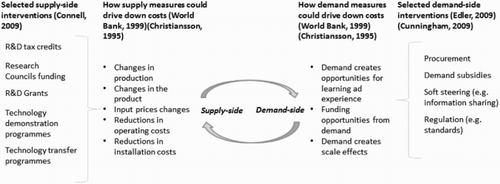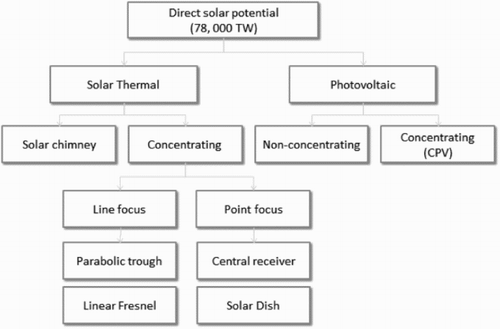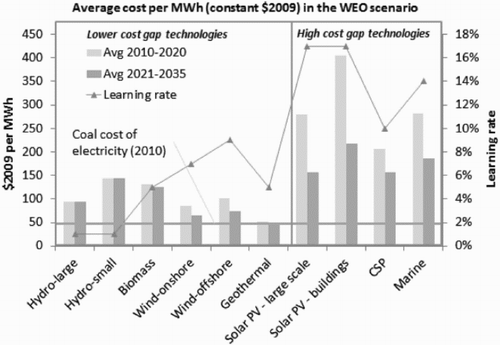Abstract
The paper provides an overview of the attractiveness of the global concentrating solar power (CSP) industry, analyses South Africa's current capabilities in developing a CSP manufacturing capacity, and then makes recommendations regarding policy measures and an associated industry roadmap for developing a competitive CSP industry in South Africa. The analyses highlight that cost reduction is currently the most important stumbling block for the large-scale rollout of CSP. From a supply, or technology-push, perspective, changes such as cost-effective production methods, improved products through directed research and development, and reductions in operating and installation costs could be implemented. From a demand, or technology-pull, perspective, more ambitious targets need to be incorporated into the current South African policies with reliable support schemes to ensure long-term investment security for CSP systems. Recommendations are made accordingly. Specifically, South Africa should continue to promote strategic collaborations with potential CSP investors to access funding possibilities for projects.
1. Introduction
There are high expectations that concentrating solar thermal energy technologies will eventually be able to compete with conventional power-generation systems on a utility scale; mostly due to the ability of this technology to store energy at a reasonable cost, its ability to provide electricity under off-grid situations, and the scalability of the technology (Deutsche Bank, Citation2009). Globally, the large-scale rollout of these technologies has, however, not yet been achieved; cost is one of the largest stumbling blocks (Deutsche Bank, Citation2009; International Energy Agency [IEA], Citation2010a, Citation2010b, Citation2010c).
The South African government has made its intension clear for a wider support of renewable energy through the adopted integrated resource plan (IRP) (Department of Energy [DoE], Citation2011), which underpins the New Growth Path and the National Development Plan (National Planning Commission, Citation2011). The policy-adjusted IRP outlines that 42% of new generation capacity, added over the 2011 to 2030 period, will be from renewables (DoE, Citation2011). The role of concentrating solar power (CSP) in the energy mix has, however, been limited to 1 GW out of the planned 17.8 GW of domestic renewables to be built, which raises questions regarding whether enough domestic demand will exist to support the development of domestic manufacturing capabilities for CSP systems; to capitalise on (potentially) future export opportunities (Lubkoll et al., Citation2012).
This paper provides an overview of the attractiveness of the global CSP industry, analyses South Africa's current capabilities in developing a manufacturing capacity, and makes suggestions regarding a policy framework and industry roadmap for developing a competitive, domestic CSP industry. A combination of literature analyses and in-depth interviews with South African technology and policy experts was used as basis for the study.
2. Useful theoretical frameworks that underpin the analysis
2.1 The rationale for government intervention: The infant industry
The ability of a developing country to diversify through self-discovery activities is key to development success (Imbs & Wacziarg, Citation2003; Rodrik, Citation2004). In developing countries, however, it is often the case that the returns on new activities are difficult to gauge and therefore investments in new industries or businesses are limited. According to Rodrik (Citation2004), information externalitiesFootnote4 and coordination externalities are the main reasons for this problem.
The notion of government intervention to support the development of a CSP industry in South Africa would therefore rest on the infant industry argument,Footnote5 whilst being cognisant of a wide range of market and systems failures (Haukes & Nordgren, 1999; Pitelis, Citation2007; Ul Haque, Citation2007; Livesey, Citation2010). The paper simplifies the analyses of these failures through the identification of barriers, as was identified by industry experts, to the development of the industry and to suggest mitigating responses to these barriers. It also provides a policy-mapping exercise where policy gaps are identified and highlighted.
2.2 South African national system of innovation: A technology colony
To develop a suggested policy framework or industry development roadmap, the nature and structure of the South African national system of innovation needs to be taken into consideration.
De Wet (Citation2001) has described South Africa as a technology colony. This is a country where the national system of innovation is still at a level of development and the country is mostly dependent on foreign technology. De Wet (Citation2001) describes the features of a technology colony as follows:
a small group of activities exist in the research end of the lifecycle, mostly taking place in research councils or institutions and the higher education sector;
there is a weak flow of technology from the research side of the product development cycle to the final products end as most products are being imported;
there is a large flow of products from the developed world into the technology colony, which occurs in the form of licensed product designs and processes, assemblies and final products – these are often implemented through a multinational firm or subsidiaries; and
the most business activity that takes place is at the end of the product lifecycle.
2.3 Industry lifecycles and technological maturity
To analyse policies and measures for developing an industry, it is useful to refer to the literature on industry evolution. Several approaches have been developed to analyse industry evolution and development. A particularly useful framework is the industry lifecycle framework (Utterback, Citation1996). The framework suggests that industries typically follow five stages: development, growth, maturity, decline and shrinking.
2.4 Cost reductions, learning curves and the influence of interventions
The key to the feasibility of renewable energies in general, and CSP in particular, is the ability of achieving cost reductions to compete with conventional electricity-generation technologies; such as coal in the case of South Africa. A number of policies are being implemented to address the cost gap, for example through feed-in-tariffs, but these policies will only be temporary, and it is thus of high importance that cost reductions be realised (World Bank, Citation1999; Christiansson, Citation1995).
Technological breakthroughs could dramatically change the experience and learning curves, and these also depend on the diffusion of these breakthroughs to realise cost reduction. is a graphical representation of the relationship between the supply and demand levers for realising cost reductions, and attempts to link these levers to policy mechanisms that are available for stimulating both the supply and demand sides.
3. CSP technology and industry attractiveness
CSP is a technology that allows for the generation of electricity through the concentration of solar energy on a focal point or line. The focused concentrated energy is then used to heat up fluids to produce steam in order to activate turbines to generate electricity (Deutsche Bank, Citation2009; European Commission, Citation2010). Various technologies exist for solar–electric conversion and specifically CSP, as depicted in .
CSP technology has a number of advantages over existing renewable sources that may make it an interesting possibility for further investigation and research and development (R&D) investment to lower costs.
Firstly, CSP can operate with integrated thermal storage systems that make electricity generation possible for a number of hours during times when there is no sunlight. This aspect of the technology is expected to provide dispatched, lower operational costs and to improve efficiency and reliability (Deutsche Bank, Citation2009; DoE, Citation2009; IEA, Citation2010a). As a case in point, the state of the art in central receivers is represented by the Gemasolar Thermasolar central receiver plant in Seville, Spain. During its first summer of operation, it broke CSP records by producing continuous full-load power for 24 hours at a time (Torresol Energy, Citation2011).
Secondly, the hybridisation of CSP is possible because it would allow for the combination of solar technology with more conventional power-generation backup at times of ongoing reduced direct solar radiation. This characteristic is also expected to further drive down costs and increases its suitability for base-load electricity generation (Deutsche Bank, Citation2009; IEA, Citation2010a, Citation2010b).
Thirdly, alternative uses of CSP may make it a very versatile technology (IEA, Citation2010a, Citation2010b):
CSP technology may be used to generate process heat, co-generation of heating and cooling, and water desalination.
Smaller scale applications, such as power generation for small-scale manufacturing and rural off-grid communities, may make it an attractive technology for developing countries to pursue.
Solar-generated hydrogen could contribute to decarbonising transport through the development of concentrating solar chemistry (including hydrogen as an energy carrier).
There is some uncertainty about which CSP technologies will emerge as dominant (Brent & Pretorius, Citation2011). Parabolic troughs are now considered mature and bankable, making them a good choice for the short term in South Africa. During the last few years, central receiver technology has emerged as the frontrunner for larger, more efficient power generation, while the parabolic dish type has been disregarded. Linear Fresnel is a promising improvement over the parabolic trough type for smaller, lower temperature application, such as process heat and small-scale power. The CSP route in the South African context provides two other incentives:
South Africa has one of the best solar resources worldwide, and in some instances this is almost 50% better than locations in Spain and California where CSP plants are in operation (Gauché et al., Citation2012a). The levelised electricity cost is approximately inversely proportional to the solar resource, which leads to an immediate cost benefit.
The heliostat field and receiver account for about 50% of the plant cost. These components are regular construction materials that are generally too bulky to import economically. If thermal storage systems can be developed locally that provide longer storage, smaller turbines can be used for the same energy production for a longer portion of the day.
4. Push and pull drives for CSP development in South Africa
As stated above, the current IRP allocates 42% of new capacity to renewables. While this may be impressive, there are some areas of concern regarding both the capacity and energy supply plans leading to 2030.
Coal capacity is increased by the addition of 16 GW of ongoing or new builds, and the addition of 9.6 GW of nuclear power is added to begin replacing coal while continuing to increase base-load capacity. IRP decision-makers selected this scenario in the promulgated plan over a scenario where renewables were prioritised in order to reduce risk. The large nuclear build is a consequence of both recognising that South Africa needs to reduce its carbon dioxide emissions and a concern of peak-oil-type increases in fuel prices (DoE, Citation2011).
While South Africa is a leading emitter of carbon dioxide and it behoves the nation to make these changes, there is concern over the choices made when also considering conventional energy resources that are utilised in the IRP. Several recent authors are reporting that South Africa (as well as the world) is overestimating the coal resource (Rutledge, Citation2011; Patzek & Croft, Citation2010; Mohr & Evans, Citation2009; Hartnady, Citation2010). These authors report that geological estimates are rapidly reducing towards their models, just as mature coal regions around the world have done. If these models are accurate, South Africa will experience peak coal within the next decade and will be 90% depleted of its ultimately recoverable coal resource by around mid-century. It is critical to note that when peak is reached, it is generally not economically possible to increase production.
Apart from the security concerns, once-through nuclear power technology does not appear to alleviate the aforementioned supply problem. Dale (Citation2012) reports on a comprehensive review of all conventional energy sources showing that fissile uranium resource estimates are all significantly smaller than fossil resources. Knapp et al. (Citation2010) show that by consuming all remaining fissile uranium by 2065, carbon emissions will reduce by less than 40%. It therefore appears that South Africa's entire base-load plan leading to 2030 is at peak-oil-type risk implying a paradoxical situation.
Two significant observations can be made in addition to the peak problem that has been described. First, the energy mix is at risk for both base-load and dispatch capacity with shrinking conventional sources; and, second, there is an abundance of renewable resources available.
A balanced mix of wind, photovoltaic and CSP systems can produce the most cost-effective sustainable power needs, but it will take considerable effort to deploy this capacity. The resources for these are intermittent and only CSP can demonstrate the ability to store energy at utility scale. When CSP forms a much smaller share of the renewable mix, renewables cannot emulate base-load or dispatch (peaking). Gauché et al. (Citation2012a) qualitatively position the various energy sources in the IRP on the plot in .
Figure 3: Qualitative positioning for all future electricity generation types to 2030
Source: Gauché et al. (Citation2012a).
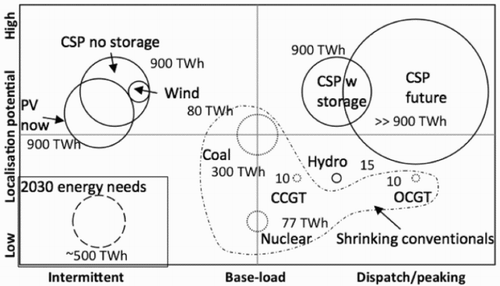
When drawn in this way CSP appears to be the ultimate solution. While the technology is a contender for post-fossil energy supply, cost and maturity are limitations. In particular, although a CSP system could be deployed to be reasonably certain of supplying all energy needs, the cost would be considerable. A cost optimal energy system with similar certainty would probably comprise all three renewable types in similar proportion.
5. Global CSP outlook to 2035
presents the estimated installed capacity, reflected as the Compound Annual Growth Rate (CAGR) of installed capacity, over the 2010 to 2035 period. It is clear from the graph that solar energy is expected to show the highest growth rates of all, albeit from a very low base, especially in the case of CSP. Over the 2010 to 2035 period a total of 88.6GW CSP will be installed worldwide (IEA, Citation2010c).
Figure 4: Representation of installed capacity for selected renewables technologies over the 2010 to 2035 period
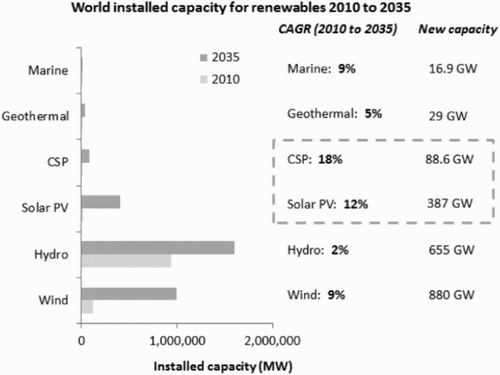
The IEA (Citation2010c) report makes use of learning rates to model the reduction of cost of generation for technologies. summarises the estimated average costs for electricity generation over the period 2010 to 2035. These costs are also compared with the cost for electricity generation through coal. From this analysis, one could conclude that solar power (photovoltaic [PV] and thermal) are both still high-cost gap technologies when compared with conventional electricity-generation technologies. Furthermore, although the cost of solar energy is expected to drop dramatically over the next two decades, it will remain more expensive than the current low-cost gap technologies. However, Sandia Labs recently released a central receiver (power tower) roadmap (Kolb et al., Citation2011) estimating that $86/MWh is achievable by 2020 and containing an early announcement of a US DoE-funded project called SunSHOT, which is awarding $60 million to projects in order to reduce CSP costs to $60/MWh by 2020. CSP, as shown in , would then be competitive.
The current R&D expenditure on renewable technologies had reached $5.6 billion in 2009 (IEA, Citation2010c); solar technologies received the bulk of the R&D spending. This is not unexpected as the growth phase technology still needs much improvement with high R&D expenditures to drive costs down. presents a summary of the statistics presented in the analysis comparing the various renewable technologies with each other. These trends are all indicative of the level of maturity of the technologies.
Table 1: Summary of key technology metrics for renewables
6. Market forecasts
Deutsche Bank (Citation2009) expects utilities to invest in CSP technology and forecasts a market growth of a 50% CAGR over the 2008 to 2015 period, making it a very attractive industry. The installed base of CSP is forecasted to reach 12 to 18 GW in 2020.
Although limited to countries in the ‘sunbelt’, CSP is expected to evolve into a real alternative to conventional power generation at competitive levels. provides insight into the projects executed and planned over the 2007 to 2020 period.
Figure 6: Planned CSP projects worldwide
Source: Deutsche Bank (Citation2009).
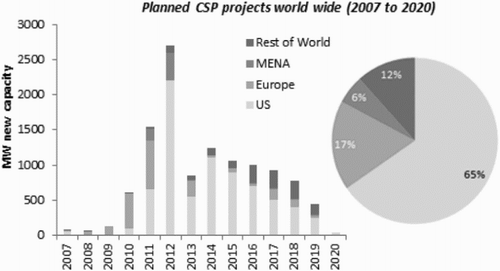
The United States and Europe (more specifically Spain) are the largest markets for CSP. Spain, however, placed caps on CSP installations that resulted in Spanish manufacturers and project developers looking for new markets. This may pose an opportunity but also a threat to developing a CSP industry in South Africa.
7. Policy intervention categories and international best practice
Technology maturity, or position in the respective lifecycles, is important from two perspectives:
understanding the relative maturity of an industry to decide on entering the industry sector; and
ensuring a balanced policy environment with various projects across the industry lifecycle.
IEA (Citation2008) suggests key principles for the development of a policy framework for renewable energy industry development. The effectiveness and efficiency of renewable energy policies are greatly affected by the adherence of certain key policy design principles. summarises the key principles and actions to be taken.
Table 2: Summary of key renewable energy policy principles adapted from IEA (Citation2008)
A renewable energy policy thus needs to be balanced to support various technologies along the different stages of maturity. combines the industry lifecycle approach and an analysis of IEA (Citation2008) to provide an overview of the general policy stance to be taken for renewables across the various stages of their lifecycles.
Figure 7: Technology lifecycle and technology development levels as outlined in IEA (Citation2008)
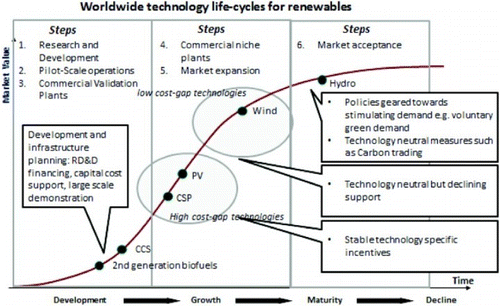
8. Developing a CSP industry in South Africa
One should take into consideration that the structure and needs of a technology colony look very different from the needs of a country with an advanced system of innovation. For this reason, the strategic recommendations of the paper combine forward integration (focused on R&D and innovation) measures and backward integration (technology transfer) measures.
applies the framework developed previously to the existing technology colony concept and provides the framework from which the initiatives for South Africa were analysed. The initiatives are discussed according to the incentives as outlined in . As per the basic design principles for the development of a policy framework, as outlined by IEA (Citation2008), the following two aspects are addressed:
identifying non-economic barriers for industry development and suggesting mitigating measures; and
analysing the policy environment from a supply-side and demand-side perspective, and outlining the suggested approach and policy gaps and making recommendations regarding mechanisms to address these gaps.
8.1 Non-economic barriers
8.1.1 Lack of coordination
The analysis indicated that there is a general lack of coordination of incentives and initiatives for the development of the CSP industry. Different government departments administer various measures, and a lack of communication has resulted in delays for projects to go ahead and has (also) confused investors as to how to utilise the various incentives. For instance, the Industrial Development Corporation has 540 MW of CSP projects on their books that they will support through equity and debt, while the DoE has only 200 MW planned for capacity. The interviewees have also indicated a disconnect between the activities of the Department of Trade and Industry (DTI) and the Department of Science and Technology, where a distinct lack of coordination exists in aligning industrial policy-making with initiatives for domestic innovation and technology development for CSP (Department of Science and Technology, Citation2010; DTI, Citation2011).
8.1.2 Difficulties in accessing the grid
Difficulties in accessing the grid have been identified as a barrier to large-scale rollout of CSP. Specifically, transmission-oriented infrastructural expansions into the ‘sunbelt’ areas will be necessary (Edkins et al., Citation2009); the investment requirements will be of the same order of magnitude as the actual generation investments.
8.2 Supply-side analysis
8.2.1 Development of a renewable energy manufacturing cluster
All stakeholders, in general, are positive that the development of a renewable energy manufacturing cluster would be effective for realising sustainable development. Parameters that could guide such a policy include the protection for local manufacturers against excessively inexpensive technology development elsewhere, and a desirably malleable cluster in terms of its scope and size.
8.2.2 Directing government investment in particular renewable energy technologies
In general, the business sector tends to be sceptical of the effectiveness of direct government investment in a particular form of renewable energy; market forces and the private sector should rather determine what renewable energy should take preference. Conversely, non-government organisations tend to be highly supportive of this particular measure, and view it as a solution that could lead to both locally designed and manufactured projects (and products). While the private sector may be a more efficient and effective innovator than the public sector, and thus may be hampered by misguided government interventions that ‘pick winners’, others suggest that it is difficult for markets to mature without some government direction or intervention. Indeed, many feel that there is a sense of urgency to ‘pick a winner’ as soon as possible to facilitate the rapid scaling-up of renewable energy technologies, and to position South Africa in the global marketplace in terms of supplying CSP technologies.
8.2.3 Expanding South Africa's innovative capacity and investment in R&D
Although South Africa has industries with considerable manufacturing capabilities, the country currently still has almost no experience in CSP technology. While developing CSP technology is complicated and requires refinement with pilot plants, the vast majority of plant components and materials are standard industrial components and materials that are available in South Africa.
provides a top-level analysis of current CSP research and potential manufacturing capabilities in South Africa. In line with the technology colony framework, South Africa has a small but dedicated group of researchers distributed between universities, the Council for Scientific and Industrial Research and Eskom that have research capabilities in CSP-related technology areas. Very limited research funding is currently available for the technology and will have to be increased if South Africa is to contribute to the development of CSP-oriented intellectual property (see ).
Figure 9: CSP research and potential manufacturing capabilities in South Africa
Source: DoE (Citation2009).
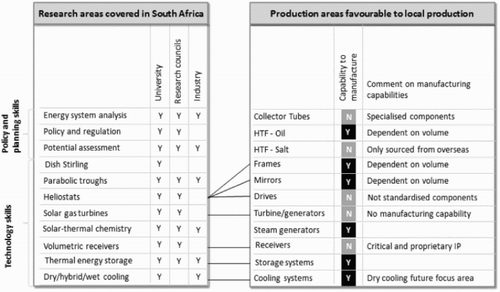
Table 3: Identified supply-side policy gaps and suggestions
shows a number of production areas favourable to local production and linked with research capabilities. From this analysis it could be concluded that (DoE, Citation2009):
South Africa currently only has production capabilities for simple and standardised components;
industrial research capabilities exist in CSP that also may indicate existence of more applied research capabilities in the system;
South Africa has emerging technology development capabilities in cooling systems, thermal energy storage and heliostats; and
much of the ability to manufacture locally will depend on volume and scale.
CSP is currently heavily reliant on water use, and the areas in the ‘sunbelt’ of South Africa are very dry with limited supply of water. South Africa should thus further develop existing capabilities in dry-cooling and water-saving technologies to remove this barrier (Edkins et al., Citation2009, Citation2010).
8.2.4 Capitalising on supply structure constraints internationally
South Africa has a mature manufacturing sector and industries. For example, the automotive and defence sectors have expressed interest in expanding existing manufacturing capabilities to manufacture components for CSP. Furthermore, the Industrial Policy Action Plan specifically addresses CSP as a manufacturing opportunity for the country, as one Key Action Programme (DTI, Citation2011).
The supply structure is, globally, still premature, and therefore large-scale sourcing of critical parts need to be planned for well in advance (Deutsche Bank, Citation2009). This in essence may indicate a potential opportunity for South Africa to become involved in developing supply structures for the international market.
8.2.5 Supply-side policy mechanism gaps and suggestions
outlines the key supply-side, or technology-push, policy mechanisms that have been identified.
8.3 Demand-side analysis
8.3.1 Developing appropriate financing schemes
A key requirement of stimulating the demand side is the development of appropriate financing schemes. The concerns thus far that need to be addressed include the lack of successful precedents in South Africa, the potentially high costs associated with an immature CSP industry, and a lack of leadership or will within commercial banking entities.
8.3.2 Incentivising a voluntary green energy market
Despite some momentum towards the development of a voluntary green energy market, both business and non-governmental organisations are sceptical about its ultimate success in the absence of significant international pressure; voluntary measures alone are insufficient to stimulate pervasive behaviour change or dramatic market shifts.
8.3.3 Creating a market of South African technology
Fostering demand for South African technology and for CSP projects in the Southern African region may also prove to be beneficial for the stimulation of a South African CSP manufacturing sector. The potential for developing CSP projects in Namibia and Botswana with the agreement for buying electricity from these countries may result in a win–win situation for all parties. Besides the advantage of greater industrialisation, expanding CSP technologies in the region will mitigate the effects of localised or regional weather systems, thus enabling the more reliable supply of electricity for the greater South African region, as demonstrated by Gauché et al. (Citation2012b).
8.3.4 Adjusting the integrated resources plan
The recently published IRP of South Africa stipulates planned expansions and builds for electricity generation over the 2010 to 2030 period. The scenarios developed for this plan are cost-optimised scenarios, which led to a ‘policy-adjusted IRP’. In order to stimulate the conditions for creating a domestic industry, renewables (solar PV, CSP and wind) have been brought forward in the published plan as outlined in (DoE, Citation2011).
Figure 10: Representation of policy-adjusted IRP capacity analysis
Source: DoE (Citation2011).
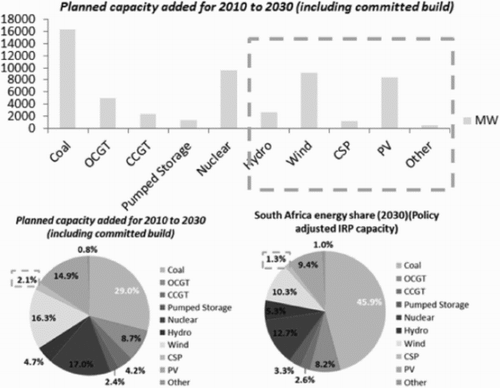
The IRP was developed mostly on cost considerations, which presumably explains the new emphasis that solar PV, which is currently cheaper than CSP, has received as compared with CSP. The interviewees highlighted the absence of ambitious targets to drive the uptake of CSP technology and, then, to significantly drive down costs. As one interviewee stated:
we need 100 to 200 MW per year to locally have an industry and to fully be able to develop technology we need to install 300 to 400 MW a year. What has been planned in the IRP for South Africa is the bare minimum. (Industry specialist, interviewed in Johannesburg in April 2011).
8.3.5 Demand-side policy mechanism analysis and suggestions
outlines the key demand-side, or technology-pull, policy mechanisms that have been identified.
Table 4: Identified demand-side policy gaps and suggestions
9. Conclusions
South Africa is typical of a technology colony in that there currently is a lack of, firstly, investment in R&D and, secondly, the translation of R&D into technological (CSP) development. If South Africa is to develop a CSP manufacturing capability, then CSP technology will initially have to be manufactured under license (Grant, Citation2008). Nevertheless, CSP is a young technology and there is still space in the global market for South Africa to become involved in technology development and large-scale manufacturing; thereby, potentially, establishing a new export industry.
The analysis highlights the following key action points for developing and establishing a CSP industry:
Cost reduction is the most important stumbling block for the large-scale rollout of CSP. Supply-side changes such as more cost-effective production methods, improved products through directed R&D, and reductions in operating and installation costs could be implemented. On the demand side, more ambitious targets need to be incorporated in the current South African policies with reliable support schemes to ensure long-term investment security for CSP energy.
The transmission grid needs to be expanded and upgraded to enable large-scale CSP implementation.
Creating markets for South African technology to stimulate demand in the region by, for example, launching CSP projects in Namibia and Botswana could result in a win–win outcome for all parties involved.
South Africa should continue to promote strategic collaborations with potential CSP investors to access funding possibilities for projects.
South Africa should establish solid data-gathering capacities and systems in order to monitor improvements in cost performance and learning in order to ensure best-practice sharing and eventual standardisation.
draws on these recommendations and outlines an in-principle CSP industry development roadmap for South Africa.
Notes
4An externality is a side effect or consequence of an industrial or commercial activity that affects other parties without this being reflected in the cost.
5The rationale for government intervention is satisfied due to failure of the private sector to accurately gauge the benefits of taking on the risk to establish a new industry.
References
- Brent AC & Pretorius MW, 2011. Industrial and commercial opportunities to utilise concentrating solar thermal systems in South Africa. Journal of Energy in Southern Africa 22(4), 15–30.
- Christiansson, L, 1995. Diffusion and learning curves of renewable energy technologies. Working Paper 95–126, International Institute for Applied Systems Analysis (IIASA). http://www.iiasa.ac.at/Admin/PUB/Documents/WP-95-126.pdf Accessed 30 July 2012.
- Connell D, 2009. Exploring the myths of government innovation policy: Why encouraging R&D contracts for customers is the key to a successful innovation economy. UKIRC Innovation Summit, UK–Innovation Research Centre, Imperial College Business School, London.
- Cunningham P, 2009. Demand-side innovation policies. Manchester Institute of Innovation Research, University of Manchester, Manchester. http://wbc-inco.net/object/document/7210/attach/TrendChart_demand-side_policies_innovation_needs.pdf
- Dale, M, 2012. Meta-analysis of non-renewable energy resource estimates. Energy Policy 43, 102–22. doi: 10.1016/j.enpol.2011.12.039
- DoE (Department of Energy), 2009. Concentrated solar power: The case for industrialisation in South Africa. Workshop on the Industrial Potential of Concentrated Solar Power. http://www.remtproject.org/FileDownload.aspx?FileID=33 Accessed 30 July 2012.
- DoE (Department of Energy), 2011. Integrate Resources Plan for Electricity: 2010–2030. Revision 2. http://www.DoEirp.co.za/content/IRP2010_2030_Final_Report_20110325.pdf Accessed 30 July 2012.
- DTI (Department of Trade and Industry), 2011. Industrial Policy Action Plan 2011/12–2013/14: Economic Sectors and Employment Cluster. http://www.dti.gov.za/industrial_development/industrial_development.jsp Accessed 30 July 2012.
- DST (Department of Science and Technology), 2010. Solar Energy Technology Roadmap for South Africa. Prepared by the Centre for Renewable and Sustainable Energy Studies, Stellenbosch University and the Graduate School of Technology Management, University of Pretoria, South Africa.
- Deutsche Bank, 2009. The CSP industry: An awakening giant. Global Markets Research Report, Deutsche Bank, London.
- De Wet, G, 2001. Emerging from the technology colony: A view from the South. Working Paper, Department of Engineering & Technology Management, University of Pretoria, South Africa.
- Edkins M, 2009. CSP workshop Report. Energy Research Centre, University of Cape Town.
- Edkins, M, Marquard, A & Winkler, H, 2009. Large-scale Rollout of Concentrating Solar Power in South Africa. Energy Research Centre, University of Cape Town. http://www.erc.uct.ac.za/Research/publications/09Edkins-etal-Rollout_of_CSP.pdf Accessed 30 July 2012.
- Edkins, M, Marquard, H & Winkler, H, 2010. South Africa's renewable energy policy roadmap. Final Report developed for the United Nations Environment Programme (UNEP). http://www.erc.uct.ac.za/Research/publications/10Edkinesetal-Renewables_roadmaps.pdf Accessed 30 July 2012.
- Edler, J, 2009. Theme 5: Demand policies for innovation in EU CEE countries. Paper presented at the workshop Innovation for Competitiveness (INCOM), Prague, January 2009.
- European Commission, 2010. Concentrated Solar Power. http://www.setis.ec.europa.eu/technologies/Concentrated-solar-power Accessed 30 July 2012.
- Gauché, P, von Backström, TW & Brent, AC, 2012a. A value proposition of CSP for South Africa. Proceedings of the South African Solar Energy Conference (SASEC2012), Stellenbosch, South Africa, May 2012.
- Gauché, P, Pfenninger, S, Meyer, AJ, von Backström, TW & Brent, AC, 2012b. Modeling dispatchability potential of CSP in South Africa, Proceedings of the South African Solar Energy Conference (SASEC2012), Stellenbosch, South Africa, May 2012.
- Grant K, 2008. Concentrated solar power in South Africa. International Support for Domestic Climate Policies, University of Cambridge Electricity Policy Research Group. http://www.eprg.group.cam.ac.uk/wp-content/uploads/2008/12/grant_251108_final.pdf Accessed 30 July 2012.
- Hartnady, CJH, 2010. South Africa's diminishing coal reserves. South African Journal of Science 106(9/10), 18–22. doi: 10.4102/sajs.v106i9/10.369
- Hauknes, J & Nordgren, L, 1999. Economic rationales of government involvement in innovation and the supply of innovation-related services. STEP, TSER/RISE Programme for European Commission, Oslo.
- IEA (International Energy Agency), 2008. Deploying Renewables: Principles for Effective Policies. http://www.iea.org/g8/2008/G8_Renewables.pdf Accessed 30 July 2012.
- IEA (International Energy Agency), 2009. World Energy Outlook. IEA, Paris. http://www.worldenergyoutlook.org/media/weowebsite/2009/WEO2009.pdf
- IEA (International Energy Agency), 2010a. Technology Roadmap: Concentrating Solar Power. http://www.iea.org/papers/2010/csp_roadmap.pdf Accessed 30 July 2012.
- IEA (International Energy Agency), 2010b. Accelerating technology transitions project. Presented by Tom Kerr, Joana Chiavari at the 1st Advisory Group's meeting, Paris, June 2010.
- IEA (International Energy Agency), 2010c. World Energy Outlook 2010. Research Report. http://www.worldenergyoutlook.org/docs/weo2010/WEO2010_es_english.pdf Accessed 30 July 2012.
- Imbs, J & Wacziarg, R, 2003. Stages of diversification. American Economic Review 93(1), 63–86. doi: 10.1257/000282803321455160
- Knapp, V, Pevec, D & Matijevic, M, 2010. The potential of fission nuclear power in resolving global climate change under the constraints of nuclear fuel resources and once-through fuel cycles. Energy Policy 38, 6793–803. doi: 10.1016/j.enpol.2010.06.052
- Kolb, GJ, Ho, CK, Mancini, TR & Gary, JA, 2011. Power tower technology roadmap and cost reduction plan. Sandia National Laboratories Report SAND2011-2419. Albuquerque, NM and Livermore, CA.
- Kristinsson, K & Rao, R, 2007. Learning to grow: A comparative analysis of the wind energy sector in Denmark and India. DRUID Working Paper No. 07–18, Danish Research Unit for Industrial Dynamics, Copenhagen.
- Livesey, F, 2010. Rationales for industrial policy based on industry maturity. Working Paper 2010/1, Centre for Industry and Government, University of Cambridge, UK.
- Lubkoll, M, Gauché, P & Brent, AC, 2012. Localisation potential of linear Fresnel CSP in South Africa. Southern African Solar Energy Conference, Stellenbosch, South Africa, May 2012.
- Mohr, SH & Evans, GM, 2009. Forecasting coal production until 2100. Fuel 88, 2059–67. doi: 10.1016/j.fuel.2009.01.032
- National Planning Commission, 2011. National Development Plan: Vision for 2030. National Planning Commission, Pretoria. http://www.npconline.co.za/
- Patzek, TW & Croft, GD, 2010. A global coal production forecast with multi-Hubbert cycle analysis. Energy 35, 3109–22. doi: 10.1016/j.energy.2010.02.009
- Pitelis, C, 2007. European Industrial and competition policy: Perspectives, trends and a new approach. Policy Studies 28(4), 365–81. doi: 10.1080/01442870701640740
- Rodrik, D, 2004. Industrial policy for the twenty-first Century. CEPR Discussion Paper No. 4767. http://www.ssrn.com/abstract=666808 Accessed 30 July 2012.
- Rutledge, D, 2011. Estimating long-term world coal production with logit and probit transforms. International Journal of Coal Geology 85, 23–33. doi: 10.1016/j.coal.2010.10.012
- Torresol Energy, 2011. Gemasolar Solar Power Plant Reaches 24 Hours of Uninterrupted Production. http://www.torresolenergy.com/TORRESOL/NewsTS/gemasolar-solar-power-plant-reaches-24-hours-of-uninterrupted-production Accessed 30 July 2012.
- Ul Haque, I, 2007. Rethinking industrial policy. Discussion Paper No. 183, United Nations Conference on Trade and Development. http://www.unctad.org/en/docs/osgdp20072_en.pdf Accessed 30 July 2012.
- Utterback, JM, 1996. Mastering the Dynamics of Innovation. Harvard Business School Press, Cambridge, MA.
- World Bank, 1999. Cost reduction study for solar thermal power plants. Final report, Washington, DC. http://www.solarpaces.org/Library/docs/STPP%20Final%20Report2.pdf Accessed 30 July 2012.

